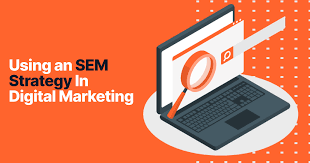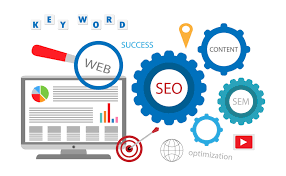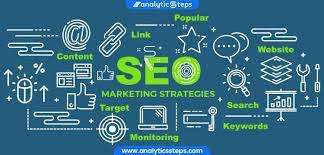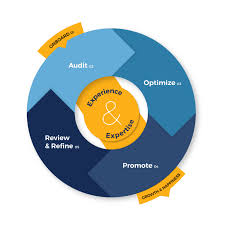Understanding the Power of SEM Marketing
Search Engine Marketing (SEM) has become one of the most influential strategies for businesses looking to achieve a competitive edge in the digital marketplace. With millions of companies vying for attention online, SEM offers a way to promote products and services effectively through paid advertisements that appear on search engine results pages (SERPs).
What is SEM?
SEM is a digital marketing strategy used to increase the visibility of a website in search engine results pages. While it can include various components, it’s most commonly associated with paid advertising – specifically pay-per-click (PPC) campaigns. Through platforms like Google Ads and Bing Ads, businesses can create ad campaigns that target specific keywords related to their products or services.
The Benefits of SEM
- Immediate Visibility: Unlike organic search strategies, which take time to yield results, SEM provides immediate visibility. Once an ad campaign is launched, your ads start appearing in front of potential customers.
- Targeted Advertising: SEM allows for precise targeting based on location, language, device, and even time of day, ensuring that your ads reach the most relevant audience.
- Measurable Results: With robust analytics tools available through SEM platforms, advertisers can track the performance of their campaigns in real-time and make data-driven decisions.
- Budget Control: Advertisers have complete control over their budgets with SEM. You can decide how much you’re willing to spend per click or per day and adjust your spending according to campaign performance.
The Role of Keywords in SEM
In SEM marketing, keywords are at the core of any campaign. These are terms or phrases that users type into search engines when looking for information. By bidding on keywords relevant to your business, you can display your ads to users who are already interested in what you offer. It’s crucial to conduct thorough keyword research and select terms that balance relevance with competition and cost-effectiveness.
Crafting Effective Ads
Your ad copy is another critical element of successful SEM marketing. It should be compelling enough to stand out amongst competitors’ ads while also being relevant and informative. A clear call-to-action (CTA) should guide potential customers on what steps they need to take next – whether it’s making a purchase, signing up for a newsletter, or learning more about your products.
The Importance of Landing Pages
Landing pages are where users ‘land’ after clicking your ad. These webpages must be optimised both for conversion and user experience. A good landing page will have clear messaging aligned with its corresponding ad copy and an intuitive layout that guides visitors towards completing a conversion action.
Sustaining Success with Continuous Optimisation
An effective SEM strategy requires continuous monitoring and optimisation. By analysing data such as click-through rates (CTR), conversion rates, quality score (in Google Ads), and cost per acquisition (CPA), advertisers can tweak their campaigns for better performance over time.
In Conclusion
Sem Marketing offers businesses an opportunity for growth by increasing online visibility through targeted advertising efforts. To reap the full benefits of SEM marketing, advertisers must focus on keyword selection, compelling ad copywriting, creating effective landing pages, and ongoing optimisation based on performance metrics.
If executed correctly, SEM can not only drive traffic but also contribute significantly towards achieving business objectives such as increased sales or leads generation – making it an indispensable tool in any modern marketer’s arsenal.
Understanding SEM Marketing: A Comprehensive Guide to Tools, Strategies, and Performance
- What is SEM vs PPC marketing?
- Whats SEM means?
- What is SEM marketing tools?
- What type of marketing is SEM?
- What is SEM mean in marketing?
- What is SEO vs SEM?
- What is SEM performance marketing?
- What is SEM marketing and how it works?
- What is an example of a SEM marketing?
- How do I start SEM marketing?
- What is SEM vs SEO vs PPC?
- What is an SEM strategy?
- What does SEM mean in marketing?
- What is SEM vs PPC?
- What is SEM with an example?
What is SEM vs PPC marketing?
A common query in the realm of digital marketing is the distinction between SEM and PPC marketing. SEM, or Search Engine Marketing, encompasses a broader strategy that includes various tactics to enhance a website’s visibility in search engine results pages. On the other hand, PPC, which stands for Pay-Per-Click, is a specific form of advertising within SEM where advertisers pay a fee each time their ad is clicked. In essence, while SEM covers a range of activities aimed at boosting online presence, PPC is a subset of SEM that focuses solely on paid advertising through platforms like Google Ads and Bing Ads. Understanding this difference is crucial for businesses looking to leverage these strategies effectively to drive traffic and achieve their marketing goals in the digital landscape.
Whats SEM means?
“SEM” stands for Search Engine Marketing. It is a digital marketing strategy that involves promoting websites by increasing their visibility in search engine results pages through paid advertising methods. SEM encompasses various tactics, with pay-per-click (PPC) campaigns being the most common. By bidding on relevant keywords, businesses can ensure that their ads appear prominently to users searching for products or services related to their offerings. SEM plays a crucial role in driving targeted traffic to websites and enhancing online presence effectively.
What is SEM marketing tools?
SEM marketing tools are essential resources that aid businesses in effectively managing and optimising their search engine marketing campaigns. These tools encompass a wide range of functionalities, from keyword research and bid management to ad performance tracking and competitor analysis. By leveraging SEM marketing tools, businesses can streamline their advertising efforts, gain valuable insights into campaign performance, and make data-driven decisions to maximise their return on investment. These tools play a crucial role in enhancing the efficiency and effectiveness of SEM strategies, empowering businesses to reach their target audience with precision and achieve their marketing objectives successfully.
What type of marketing is SEM?
SEM, which stands for Search Engine Marketing, is a form of digital marketing that involves promoting websites by increasing their visibility in search engine results pages through paid advertising. Unlike SEO (Search Engine Optimisation), which focuses on organic methods to improve a site’s ranking, SEM primarily revolves around paid strategies such as pay-per-click (PPC) campaigns. By bidding on relevant keywords and creating compelling ads, businesses can target specific audiences and drive traffic to their websites effectively. In essence, SEM is a proactive and results-driven approach to online marketing that allows companies to reach potential customers at the precise moment they are searching for products or services related to their business.
What is SEM mean in marketing?
In the realm of marketing, SEM stands for Search Engine Marketing. It refers to a digital advertising strategy that aims to increase a website’s visibility on search engine results pages through paid advertisements. SEM encompasses various tactics, with pay-per-click (PPC) campaigns being the most common approach. By bidding on specific keywords related to their products or services, businesses can place targeted ads in front of potential customers searching for relevant information online. SEM plays a crucial role in driving immediate traffic to websites and boosting brand awareness in a competitive online landscape.
What is SEO vs SEM?
A common question in the realm of digital marketing is the distinction between SEO (Search Engine Optimisation) and SEM (Search Engine Marketing). While both strategies aim to enhance a website’s visibility on search engine results pages, they differ in their approach. SEO focuses on improving organic search rankings through techniques like keyword optimisation, content creation, and backlink building. On the other hand, SEM involves paid advertising to appear prominently in search results for specific keywords. While SEO is a long-term investment that requires consistent effort to maintain rankings, SEM offers immediate visibility but requires ongoing budget allocation. Understanding the nuances between SEO and SEM is crucial for businesses looking to develop a comprehensive online marketing strategy that maximises their digital presence.
What is SEM performance marketing?
SEM performance marketing refers to the practice of using search engine marketing (SEM) strategies to drive measurable results and achieve specific performance goals. Unlike traditional advertising methods that focus solely on brand awareness, SEM performance marketing is all about delivering tangible outcomes, such as increased website traffic, lead generation, or online sales. By carefully monitoring key performance indicators (KPIs) like click-through rates, conversion rates, and return on investment (ROI), businesses can assess the effectiveness of their SEM campaigns and make data-driven decisions to optimise performance. In essence, SEM performance marketing combines the power of search engine advertising with a results-oriented approach to deliver quantifiable business impact.
What is SEM marketing and how it works?
Search Engine Marketing (SEM) is a digital marketing strategy that involves promoting a website by increasing its visibility in search engine results pages through paid advertising. SEM works by allowing businesses to create and run ads on search engines like Google or Bing, targeting specific keywords related to their products or services. When users search for these keywords, the ads appear at the top or bottom of the search results, making them visible to potential customers. Advertisers bid on these keywords, and their ads are displayed based on a combination of bid amount and ad relevance. By leveraging SEM, businesses can reach a targeted audience, drive traffic to their websites, and ultimately increase conversions and sales.
What is an example of a SEM marketing?
An example of Search Engine Marketing (SEM) marketing can be seen in a scenario where a local bakery wants to increase online visibility and attract more customers to its website. The bakery decides to run a Google Ads campaign targeting keywords like “fresh pastries near me” and “best bakery in [location]”. By bidding on these relevant keywords, the bakery’s ads appear at the top of search engine results when users in the area search for similar terms. This targeted approach helps the bakery reach potential customers actively seeking its products, driving traffic to its website and ultimately boosting sales.
How do I start SEM marketing?
Embarking on a SEM marketing journey involves several key steps to ensure a successful campaign. Firstly, conducting thorough keyword research is essential to identify relevant terms that align with your business objectives. Next, setting up accounts on SEM platforms like Google Ads and Bing Ads is crucial for creating and managing your campaigns. Crafting compelling ad copy that resonates with your target audience and directing users to optimised landing pages are vital for driving conversions. Regularly monitoring and analysing campaign performance metrics allows for continuous optimisation to maximise results. By following these steps diligently, you can kickstart your SEM marketing efforts effectively and pave the way for increased online visibility and business growth.
What is SEM vs SEO vs PPC?
One frequently asked question in the realm of SEM marketing is the distinction between SEM, SEO, and PPC. SEM, which stands for Search Engine Marketing, encompasses both SEO (Search Engine Optimisation) and PPC (Pay-Per-Click) advertising. SEO focuses on improving a website’s organic visibility in search engine results through optimisation techniques such as keyword research, content creation, and link building. On the other hand, PPC involves paying for ads to appear at the top of search engine results based on specific keywords. While SEO aims for long-term sustainable results, PPC provides immediate visibility but requires ongoing investment. In essence, SEM combines the strategies of SEO and PPC to maximise a website’s presence in search engine results pages effectively.
What is an SEM strategy?
An SEM strategy, short for Search Engine Marketing strategy, encompasses a set of techniques and tactics aimed at enhancing a website’s visibility in search engine results pages through paid advertising. This comprehensive approach involves keyword research, ad campaign creation, bid management, and performance analysis to maximise the return on investment (ROI) for businesses. By strategically targeting relevant keywords and crafting compelling ad copy, an SEM strategy aims to drive qualified traffic to a website and ultimately boost conversions. Additionally, continuous monitoring and optimisation are crucial components of an effective SEM strategy to ensure sustained success in the competitive digital landscape.
What does SEM mean in marketing?
Search Engine Marketing (SEM) in marketing refers to a comprehensive digital strategy that involves promoting a website or online presence through paid advertisements on search engine results pages (SERPs). SEM encompasses various tactics, with pay-per-click (PPC) advertising being the most common approach. By bidding on relevant keywords, businesses can ensure their ads appear prominently when users search for related terms, driving targeted traffic to their websites. SEM plays a crucial role in increasing visibility, attracting potential customers, and ultimately achieving marketing goals through strategic online advertising efforts.
What is SEM vs PPC?
A common question in the realm of digital marketing is the distinction between SEM and PPC. While the terms are often used interchangeably, they refer to different aspects of online advertising. SEM, or Search Engine Marketing, encompasses a broader range of strategies aimed at increasing a website’s visibility on search engine results pages (SERPs). PPC, on the other hand, is a specific type of advertising model within SEM where advertisers pay a fee each time their ad is clicked. In essence, PPC is a subset of SEM, focusing on paid search advertising specifically. Understanding this difference is crucial for businesses looking to leverage these strategies effectively to enhance their online presence and reach their target audience.
What is SEM with an example?
Search Engine Marketing (SEM) is a digital marketing strategy that involves promoting a website by increasing its visibility in search engine results pages through paid advertising. An example of SEM in action is when a company creates a Google Ads campaign targeting specific keywords related to their products or services. When users search for those keywords on Google, the company’s ads appear at the top of the search results, allowing them to reach a highly targeted audience actively looking for what they offer. By bidding on relevant keywords and crafting compelling ad copy, businesses can drive traffic to their website and increase conversions through SEM campaigns.




